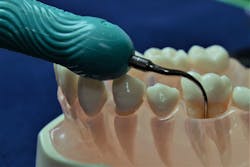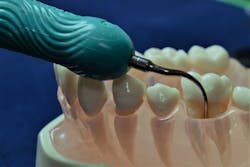Ultrasonic instrumentation in the dental hygiene curricula: Are we teaching to competency?
Marianne Dryer, MEd, RDH
As a faculty member and speaker, I have had the honor of teaching in dental hygiene programs and delivering continuing education (CE). My main focus is on ultrasonic instrumentation (UI) instruction, and my career goal is to elevate the level at which it is taught, practiced, and executed by clinicians as they continue in their careers. As such, I have recognized a common denominator over the years—
clinicians have very different ultrasonic styles or techniques, using various strokes, adaptations, and approaches, and oftentimes they are not sure why. My hypothesis is that the foundational content in the academic curricula is lacking. Calibration is an issue among faculty, and there is evidence that clinical competency exams may be lacking in progressive measurement of the developing skill.1
This article is the first of a three-part series on UI relating to students, faculty, and practicing clinicians. It portrays current US trends in ultrasonic instruction. The following articles will cover instrumentation techniques with an emphasis on calibration, optimizing ultrasonics utilizing the proper inserts, and technology while incorporating proper ergonomics and aerosol control.
Choices in instrumentation
An important aspect of this discussion is the current utilization of ultrasonic versus hand instrumentation in the workplace. Some surveys suggest it is utilized for more than 70% of the scaling or debridement procedure.2 If that is the case, it may be important to look at the amount of time that is spent in the curricula on developing this skill, along with the level of competency evaluation.
Most dental hygiene programs (97.82%) cite calculus as a criterion for using the ultrasonic scaler, with 31% indicating inflammation as a criterion for ultrasonic debridement. This suggests that dental hygiene programs are still teaching a traditional approach to instrumentation.3 Considering the vast amount of evidence implicating biofilm as the etiological factor for periodontal disease rather than calculus, perhaps it’s time to evaluate and update curricula?4–6
In another study, the authors note, “Ultrasonic instrumentation technology and technique have been evolving fairly rapidly over the last 15 years. As a result, it can be challenging for dental hygiene programs and their faculty to ensure that the most contemporary approaches are being taught and reinforced throughout all elements of educational programming.”1
On a similar note, the American Academy of Periodontology (AAP) along with the European Federation of Periodontology hosted a workshop held in Chicago in 2017.7 The intent was to examine the scientific evidence through extensive research analysis, along with prospective studies, considering environmental and systemic risk factors. The AAP Classification System had not been updated since 1999, and since then, there have been substantial changes in what we know about periodontal and peri-implant diseases. The new system provides much-needed depth and breadth to the diagnosis process and is more in line with the evidence in regard to systemic health, risk factors, and etiology of the disease in general. Academia is also tasked with teaching to the evidence.
Current methodology
The majority of programs (89.2%) introduced hand scaling instrumentation prior to ultrasonic scaling instrumentation. Sixty-nine percent of respondents reported that equal emphasis was placed both methods.3
The number of inserts introduced to students varies, but the average is approximately five, either purchased by the students or made available in the program’s dispensaries.3 Traditionally, the point of instruction is focused on the straight inserts, both standard and the slim lines, with minimal depth of instruction on the variables that cause the inserts/tips to perform differently.
Although scientific literature demonstrates that utilization of site-specific inserts maximizes efficacy and efficiency of deposit removal, minimizes root surface damage, and maximizes correct adaptation of the active tip area, consistent, calibrated instruction on inserts/tips other than the straight design is lacking.4–6
The results of the aforementioned survey suggest that the teaching of instrumentation is not fully aligned with the current treatment philosophy of periodontal debridement based on the need for thorough removal of biofilm using site-specific inserts. The end point of therapy measured by resolution or absence of inflammation versus the successful removal of calculus to determine skill competency should be evaluated.
This important article demonstrating the current usage and instruction in UI is imperative for further research in this area to determine the need for curricula changes and sequencing options to elevate the students’ experience with UI. It would be interesting to see additional studies examining the number of hours spent didactically and clinically on hand versus UI respectively versus a subjective response.
Accreditation standards
The Commission on Dental Accreditation (CODA)8 updates and revises the Accreditation Standards for Dental Hygiene Education Programs on a regular basis. The following standards may demonstrate the need to increase the instructional content and learning experiences with UI and the respective need for faculty to obtain CE and calibration in the areas which they teach.
Standard 2-9 states: “The basic clinical education aspect of the curriculum must include a formal course sequence in scientific principles of dental hygiene practice, which extends throughout the curriculum and is coordinated and integrated with clinical experience . . . ”
Intent: Learning experiences and practice time in clinical procedures are necessary to ensure sufficient opportunity to develop competence in all clinical procedures included in the curriculum. Didactic material on clinical dental hygiene should be presented throughout the curriculum.
Standard 2-10 states: “The number of hours of clinical practice scheduled must ensure that students attain clinical competence and develop appropriate judgment. Clinical practice must be distributed throughout the curriculum.”
Intent:Sufficient practice time and learning experiences should be provided during preclinical and clinical courses to ensure that students attain clinical competence. The number of hours devoted to clinical practice time should increase as students progress toward the attainment of clinical competence.
Revised DH Standard 2-24 on Curriculum Management (Implementation: January 1, 2019)
The dental hygiene program must have a formal written curriculum management plan, which includes
• an ongoing curriculum review and evaluation process with input from faculty, students, administration, and other appropriate sources;
• evaluation of the effectiveness of all courses as they support the program’s goals and competencies;
• a defined mechanism for coordinating instruction among dental hygiene program faculty; and
• a defined mechanism to calibrate dental hygiene faculty for student clinical evaluation.
Intent: To ensure the incorporation of emerging information and achievement of appropriate sequencing, the elimination of unwarranted repetition, and the attainment of student competence, a formal curriculum review process should be conducted on an ongoing and regular basis. Periodic workshops and in-service sessions should be held for the dissemination of curriculum information and modifications. Examples of evidence to demonstrate compliance may include documentation of calibration exercises and documented student evaluation of instruction and competency attainment.
Instructional sequencing
The University of Texas Health Science Center Houston, Fones School of Dental Hygiene, and The Ohio State University have all changed their curricular sequencing. Introducing ultrasonics in the preclinical course content has been incorporated in the above programs from a minimum of showing students the types of ultrasonic units, inserts, and how the technology works, to comparing and contrasting the inserts to hand instruments when foundational concepts such as shank, working edges, adaptation, and activation are being introduced. Regardless of whether the foot pedal is activated, the students are exposed to all instruments used in periodontal debridement, and ultrasonics are not merely an afterthought brought in several semesters later.
If this exposure to ultrasonics is delayed, applying lateral pressure has become ingrained. Students attempt to use ultrasonics like hand instruments, because that is what they learned. Michele Carr, MA, RDH, former program director at Ohio State University, adds:
“As the technology and evidence in UI advances, it just made sense to teach it as the first debridement instrument in the preclinical course. The reasons were twofold; cognitive learning theory relies on sequential development, which helps students learn. Translating to dental hygiene, in our program we teach assessment instruments first, which requires a light grasp. UI requires a light touch as well; therefore, cognitively, it was reasonable to teach ultrasonics before hand instruments, which require a firm grasp. In addition, anecdotally, I found that the ultrasonic was the first instrument used for debridement by most dental hygienists. So, why not teach it first?”
Philosophies and curriculum management are very unique to each institution, and while CODA guides and oversees compliance with the accreditation standards, interpretation of specific sequencing and inclusion of skill development is still left up to the individual program as long as appropriate documentation is in place.
The question must be asked: Are today’s programs teaching to the evidence regarding the importance of UI if it is introduced much later and far less in-depth than hand instruments? Three conclusions on this subject were derived from research that utilized more hands-on clinical components and experimental studies done within Canadian dental hygiene programs:1
• Dental hygiene UI education tends to be rooted in a traditional approach that underutilizes the full potential of new technology.
• Standardization of dental hygiene ultrasonic curricula based on current evidence would improve practice outcomes.
• Ongoing professional development for clinical dental hygiene educators in UI, the articulation of clinical objectives, and the use of evaluation rubrics would enhance UI instruction in dental hygiene programs and its clinical use by new graduates.
The next article in this series will speak to specific techniques, technologies, and the fundamental components of ultrasonic instruction that are essential to skill development and optimal clinical outcomes.
References
1. Asadoorian J, Botbyl D, Goulding M. Ultrasonic instrumentation instruction in Canadian dental hygiene programs: Perspectives of program directors on curricular elements. Can J Dent Hyg. 2017;51(1):7-15.
2. Periodontics monthly poll. Dentaltown website. https://www.dentaltown.com/magazine/articles/7402/poll. Published January 2019.
3. Hinchman SS, Funk A, DeBiase C, Frere C. Ultrasonic instrumentation instruction in dental hygiene programs in the United States. J Dent Hyg. 2016;90(2):135-142.
4. Carr M. Ultrasonics. Access. 1999;22(Special Suppl):2-9.
5. Costerton W, Schaudinn C, Melrose D. Dental biofilms in the oral cavity. Dimensions. 2011;6-22.
6. Matsuda SA. Ultrasonics for periodontal therapy. Access. 2010;24:40-42.
7. Caton GJ, Armitage G, Berglundh T, et al. A new classification scheme for periodontal and peri-implant diseases and conditions - Introduction and key changes from the 1999 classification. J Clin Periodontol. 2018;45(Suppl 20):S1-S8. doi:10.1111/jcpe.12935.
8. Accreditation Standards for Dental Hygiene Education Programs. Commission on Dental Accreditation. https://www.ada.org/~/media/CODA/Files/2019_dental_hygiene_
standards.pdf?la=en. Originally published January 1, 2013. Republished 2018. Updated September 2018. Revised Standards Implemented January 1, 2019.
Marianne Dryer, MEd, RDH, is a dynamic speaker, educator, and consultant in curriculum development. She has lectured nationally and internationally on periodontal instrumentation with a focus on ultrasonic technique, risk assessment, infection prevention, and
radiology technique. Her experience in dentistry spans more than 30 years. She is a graduate of Forsyth School for Dental
Hygienists, Old Dominion University, and received her master’s in education from St.Joseph’s College of Maine. Contact her at cerenewed@
mariannedryer.com or through her website at mariannedryer.com.


